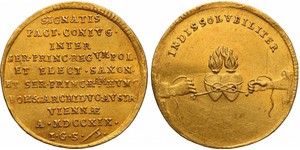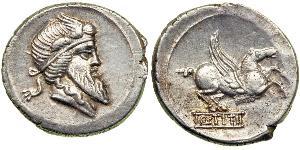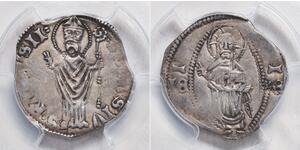[ 3300] Cn. Lentulus Silver Denarius (19mm, 3.82 gm), Spain, 76/5 B.C. Reference: Cornelia 54; B.M.C., Spain, 52; Syd. 752; Craw. 393/1a G . P . R . above diademed bust of the Genius of the Roman people draped bright, scepter on shoulder. EX S.C. divided by Terrestrial Globe between rudder and scepter, CN . LEN . Q below. This coin was struck when the moneyer was acting as paymaster to Pompey's troops in Spain. Provided with Certificate of Authenticity. CERTIFIED AUTHENTIC by Sergey Nechayev, PhD - Numismatic Expert Pompey (Latin nominative Gnaeus Pompeius Magnus), also known as or Pompey the Great (Classical Latin abbreviation: CN·POMPEIVS·CN·F·SEX·N·MAGNVS) (September 29, 106 BC – September 29, 48 BC), was a military and political leader of the late Roman Republic. He came from a wealthy Italian provincial background, and established himself in the ranks of Roman nobility by successful leadership in several campaigns. Sulla addressed him by the cognomen Magnus (the Great) and he was awarded three triumphs. Pompey joined his rival Marcus Licinius Crassus and his ally Julius Caesar in the unofficial military-political alliance known as the First Triumvirate. The first triumvirate was validated by the marriage between Julia (daughter of Julius Caesar) and Pompey. After the deaths of Crassus and Julia, Pompey's wife and Caesar's daughter, Pompey sided with the optimates, the conservative and aristocratic faction of the Roman Senate. Pompey and Caesar contended for the leadership of the Roman state leading to a civil war. When Caesar defeated him at the battle of Pharsalus he sought refuge in Egypt, where he was assassinated. His career and defeat are significant in Rome's subsequent transformation from Republic to Principate and Empire. The Roman Republic was the phase of the ancient Roman civilization characterized by a republican form of government. It began with the overthrow of the Roman monarchy, c. 509 BC, and lasted over 450 years until its subversion, through a series of civil wars Principate form of government and the Imperial period. The Roman Republic was governed by a complex constitution, which centered on the principles of a separation of powers and checks and balances. The evolution of the constitution was heavily influenced by the struggle between the aristocracy (the patricians), and other talented Romans who were not from famous families, the plebeians. Early in its history, the republic was controlled by an aristocracy of individuals who could trace their ancestry back to the early history of the kingdom. Over time, the laws that allowed these individuals to dominate the government were repealed, and the result was the emergence of a new aristocracy which depended on the structure of society, rather than the law, to maintain its dominance. During the first two centuries, the Republic saw its territory expand from central Italy to the entire Mediterranean world. In the next century, Rome grew to dominate North Africa, the Iberian Peninsula, Greece, and what is now southern France. During the last two centuries of the Roman Republic, it grew to dominate the rest of modern France, as well as much of the east. At this point, the republican political machinery was replaced with imperialism. Roman Empire is a matter of interpretation. Towards the end of the period a selection of Roman leaders came to so dominate the political arena that they exceeded the limitations of the Republic as a matter of course. Historians have variously proposed the appointment of Julius Caesar as perpetual dictator in 44 BC, the defeat of Mark Antony at the Battle of Actium in 31 BC, and the Roman Senate's grant of extraordinary powers to Octavian (Augustus) under the first settlement in 27 BC, as candidates for the defining pivotal event ending the Republic. Many of Rome's legal and legislative structures can still be observed throughout Europe and the rest of the world by mo ...
más ...
Similar Coin Groups

1 Tetradracma Período Helenístico (332BC ...
grupo tiene 2 monedas / 2 precios
Add coin to this group

1 Ducat República de las Dos Naciones (1 ...
grupo tiene 5 monedas / 3 precios
Add coin to this group
2025-05-27
- Historical Coin Prices
2025-05-29
- New coin is added to 1/2 Cent Reino de los Países Bajos (1815 - ) Cobre Guillermo ...
1/2 Cent Reino de los Países Bajos (1815 - ) Cobre Guillermo ...
grupo tiene 10 monedas / 10 precios
⇑
Netherlands - 1/2 Cent 1873
Usted podría estar interesado en …














-300-150-ZwusHgTycaAAAAGPadNVj7Mq.jpg)






